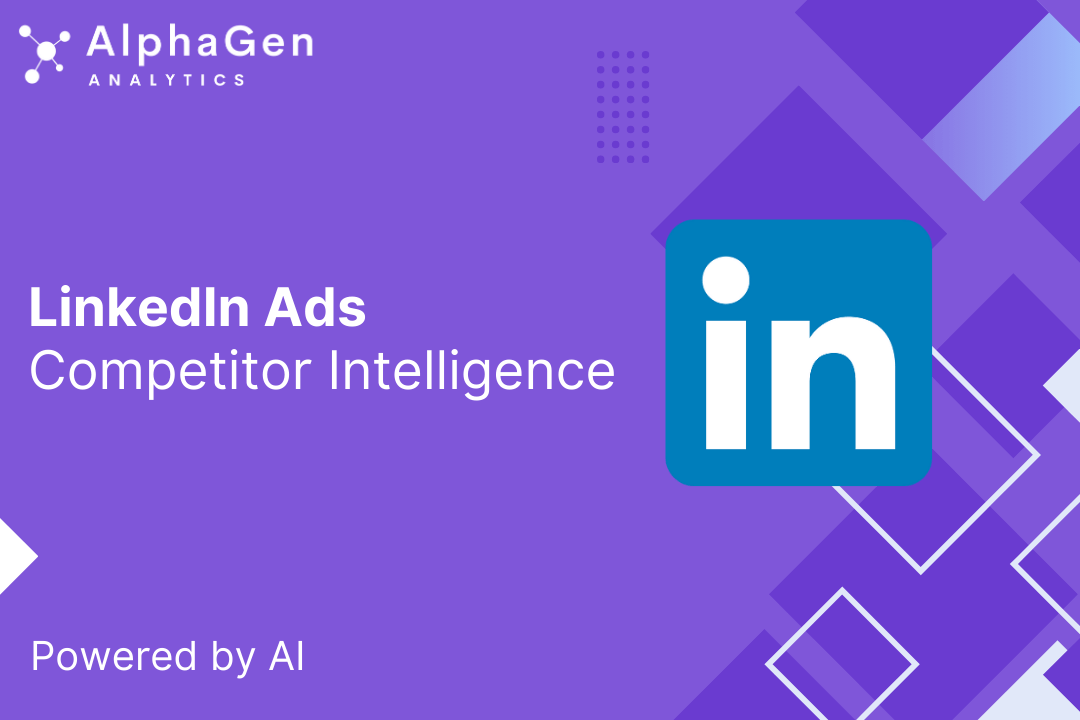Table of contents
Are you manually scrolling through your competitors LinkedIn ads, trying to piece together their strategy?
Introduction
The LinkedIn Ads Library offers a glimpse into your competition, but just seeing their ads listed one by one does not provide you any real historical insight and certainly no real strategic intelligence.
There is no way to benchmark against your competitors unless you are willing to put in a huge amount of manual work.
Until now!
Key Takeaways
- By using natural language processing, you can identify specific combinations, like pain points paired with benefits, and track their performance across different markets.
- Using AI gives you better insights than ever before without spending any time manually trying to figure out their strategy across different markets and regions.
- To get deep level insights about your competitors LinkedIn ad strategy, at scale, you need a specialized tool with AI labeling capabilities.
The LinkedIn Ads Library
Most of your competitors ads can be found in the LinkedIn Ads Library.
According to LinkedIn you can find ads created on or after June 1, 2023 and new ads will appear usually within 24-48 hours after they get their first impression.
The start dates and end dates given refer to their first and last impression dates as opposed to their ‘active’ dates.
Whilst you can use their search filters on the home page it is best to actually search using each of your competitor’s ad library ID number to ensure you can get all ads from a particular LI company page.
How to find it:
1️⃣ Go to a competitor’s LinkedIn Page
2️⃣ Click on the Posts tab
3️⃣ Select Ads, this will redirect you to the ads library and in the URL you will notice their company ID listed at the end of the URL – /search?companyIds=XXXX
You will only be able to see a few ads at a time, you will have to be constantly scrolling to get more ads to appear, so whilst this is handy that you can access all their ads, to make the most of all this access you need a better way of working with it.
Reverse Engineering Competitor Strategies
Most marketers can only monitor a handful of competitors ads effectively, being able to track campaign changes, messaging patterns, and creative variations becomes a time intensive process with diminishing returns.
Each competitor might run multiple campaigns across different regions, with various message combinations and creative styles. Trying to analyze all these manually makes it impossible to see how messaging evolves over time or which creative approaches persist in specific markets.
The following best practices will require a specialized tool with AI labeling capabilities, like AlphaGen, to deliver results at scale.

Messaging Analysis
Dedicated AI tools can process and analyze thousands of LinkedIn ads, revealing patterns in messaging and creative strategies.
By using natural language processing, you can identify specific combinations, like pain points paired with benefits, and track their performance across different markets.
Rather than manually categorizing ad copy or getting AI to try to make sense of unstructured data, AI can automatically detect and label messaging elements like:
- Value propositions
- Pain points
- Benefits
- Calls to action
- Social proof
The application of labels like this at scale provides a contextual data layer that enables AI to instantly analyze and provide almost limitless insights.
It will reveal which message combinations appear most frequently in long running campaigns, a strong indicator of what’s working for competitors.
Once you have analyzed all their ads and broken them down into regions you can start to understand the core idea behind their ads.
You will easily see patterns in:
- Tone: Are they using a professional, conversational, or playful voice?
- Value Proposition: Are they focusing on cost savings, innovation, or ease of use?
- Pain Points: Do they talk about manual work, compliance, scalability or resource issues?
- Call-to-Action: Are they driving users to sign up, download, or book a demo?
For example, if a competitor keeps running ads about “saving time with automation”, they’re betting that time saving resonates with their audience. If that aligns with your offering, you might want to test a similar approach or pivot to a message they aren’t focusing on.
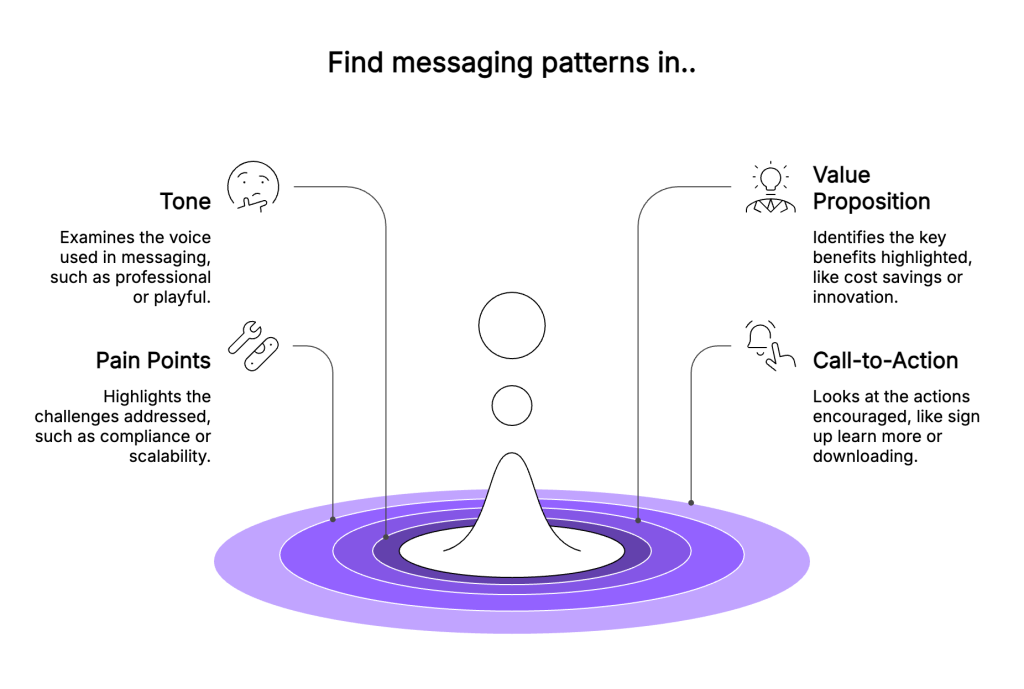
These type of insights at scale are not possible using existing manual methods or without using the right software.
Examine Creative Strategy
Being able to successfully review creatives at scale is as much a challenge for your internal ads as it is for your competitors.
We can use AI again to solve this problem, computer vision has made huge strides forward and is now a reliable source of reporting both text and visual elements at incredible speed.
Instead of sifting through countless screenshots, you can get instant insights into creative trends, from dominant colors and design styles to the use of human faces and specific visual elements.
Are competitors shifting toward minimalist visuals? Are bold colors outperforming muted tones? Is user-generated content becoming more dominant?
Some creative labels you might want to track:
- Visual Style: Minimalist, Geometric, Abstract, Photography-based, Illustration-heavy, Gradient-focused
- Colors: High-contrast, Monochromatic, Brand-color dominant, Muted palettes
- Composition Elements: White space ratio, Text overlay positioning, Grid layout, Asymmetrical balance
- Image Type: Product mockups, Team photos, Interface screenshots, Data visualizations
- Human Presence: Lifestyle shots, close up portrait, corporate, group images or no people at all
This approach helps you to understand not just what your competitors are talking about but what they are showing and how they’re presenting it visually across different markets and regions.
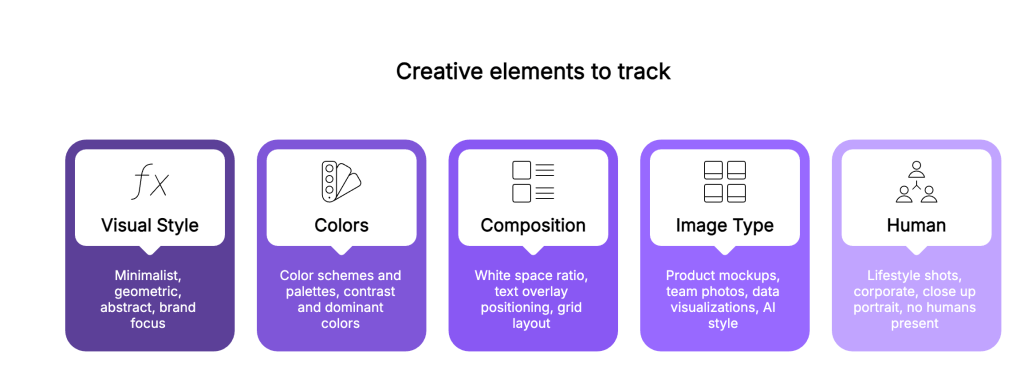
Different Ad Formats
When competitors consistently run similar ad types and messaging over months, they’re likely seeing positive results. Short-lived ads and campaigns often indicate testing or poor performance.
Using the learnings gleaned from the messaging and creatives combined with the different ad formats will give you a clear picture of the overall LinkedIn ad strategy.
Different formats generally work for different objectives. Here’s what to look for:
- Carousel Ads: Used for storytelling or showcasing multiple product features.
- Video Ads: More engaging but often used at the awareness stage.
- Single-Image Ads: Simple, clear, and effective for direct offers.
- Thought-Leader Ads: Personal profiles often perform better than brand pages.
- Conversational Ads: Interactive chatbot style ads that appear as direct messages in LinkedIn inboxes.
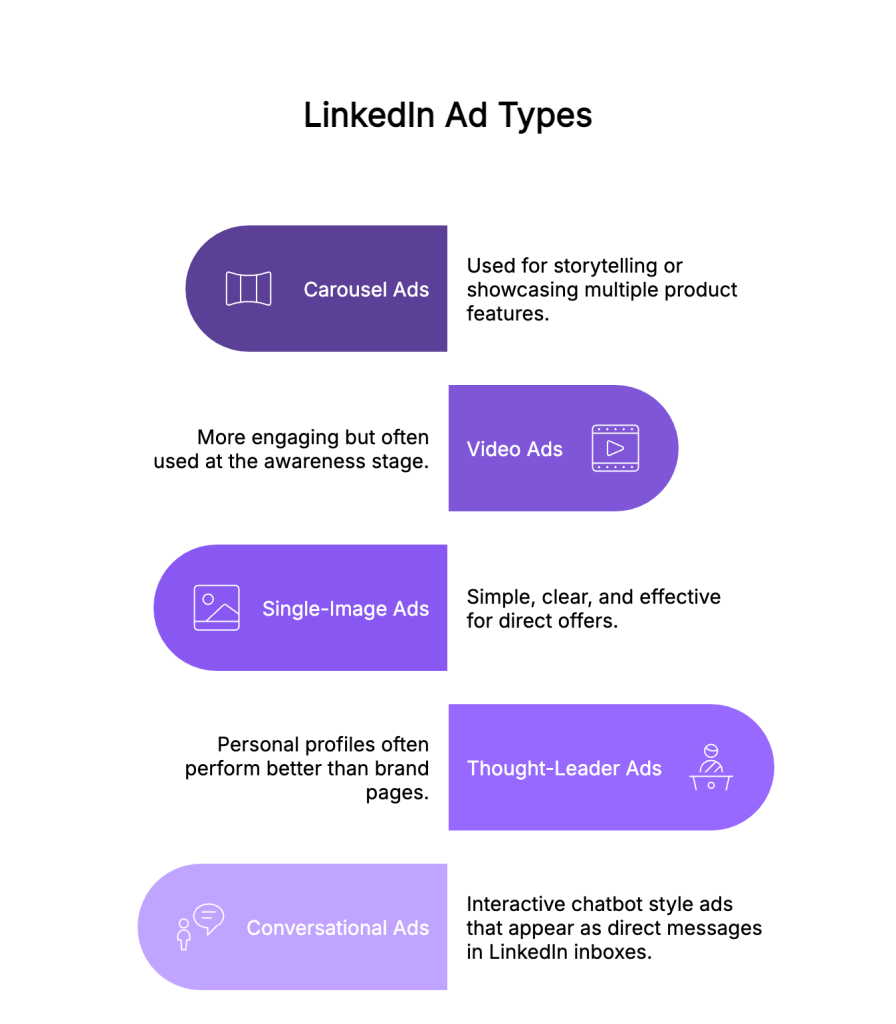
Spot Trends Over Time
Now with a tool like AlphaGen you can easily track these insights over a period of weeks or months.
If a competitor starts testing more video ads or shifts messaging toward ‘ROI‘ rather than ‘ease of use‘, they’re learning something, and you should pay attention.
Ad duration signals performance. When competitors consistently run similar ad types and messaging over months, they’re likely seeing positive results.
Look for patterns that persist:
- Message combinations that appear repeatedly
- Creative styles that get extended runs
- Geographic variations that remain consistent
- Target audience refinements that stick
Example:
You notice a B2B competitor in the project management space gradually moving away from product-focused ads to comparison-style ads that call out competitors directly. This suggests they’ve found that prospects in their space respond better to direct competitive positioning.
If a competitor is shifting their focus, it’s likely based on real engagement data. Consider testing comparison-style messaging to see if your audience responds similarly.
Don’t just watch what competitors are doing, unpack why they’re doing it. By identifying patterns in messaging, creative choices, and shifts over time, you can refine your own strategy too.
Estimating Ad Spend & Volume
What everyone would like to know is actually how much are the competition investing across all these different messages and creatives.
Estimated Impressions
While LinkedIn doesn’t reveal exact budgets, it does provide estimated impressions data for the EU region.
Using this information, and by adding your own estimated CPM that is generally accepted as benchmark for your sector, you can start to understand the investment for all ad types, messages and creative elements all across the EU.
If Competitor A’s ads have significantly higher impressions than Competitor B’s, they’re likely investing more. If their impression volume suddenly spikes, they could be launching a new product push or end-of-quarter blitz.
Track their impression trends over time. If you see a competitor ramping up impressions before a major industry event, they might be increasing spend to dominate the conversation.
Ad Volume & Consistency
Even outside the EU, you can estimate spend based on the number of active ads and how often they refresh them.
- Low-volume, long-running ads? They’re likely testing a few proven winners on a tight budget.
- High-volume, frequently changing ads? They’re spending aggressively, testing, and optimizing.
- Sudden spikes in ad volume? They may have launched a new campaign or seasonal push.
By cross referencing the estimated impressions data for their EU ads alongside their ad duration, you can use this as a benchmark for ads outside the EU to get a rough estimate of their spend globally.
If competitors ramp up ads during specific periods, consider adjusting your budget to compete, or launching complementary campaigns when their spend drops.
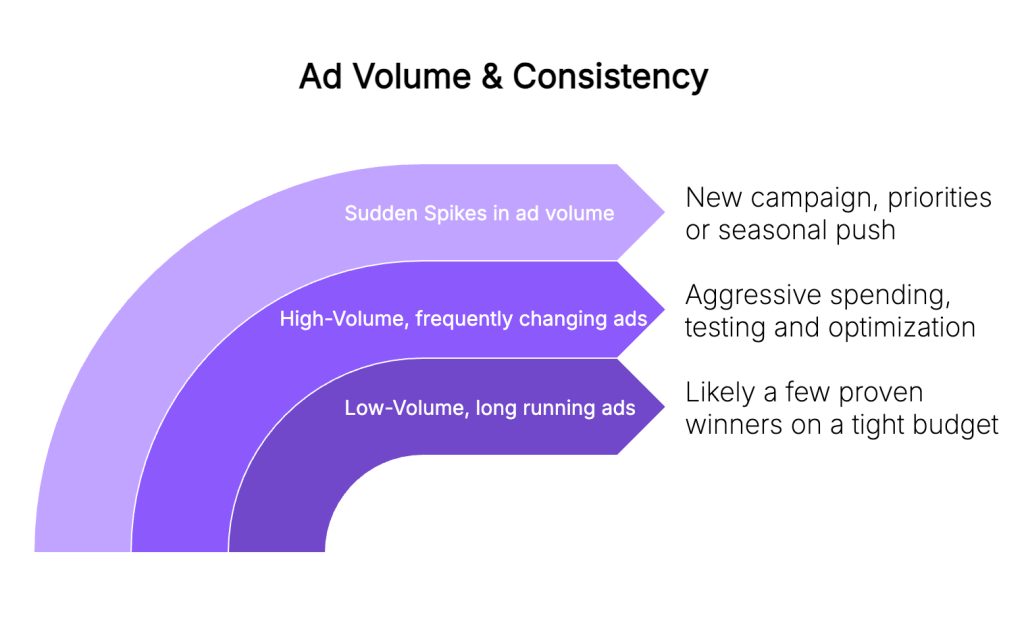
Competitor Targeting Tactics
LinkedIn doesn’t openly share detailed targeting data. But with a few clever moves, you can get pretty close.
Every time you see a sponsored post, you can check why it was shown to you.
How to do it:
1️⃣ Click the three dots on the upper-right corner of a LinkedIn ad.
2️⃣ Select “Why am I seeing this ad?”
3️⃣ LinkedIn will reveal some basic targeting details, such as:
- Job titles
- Company industries
- Location
- Interests
You keep seeing ads from a competitor promoting their freemium plan. When you check why, LinkedIn says they’re targeting small business owners and startup founders, a different segment than their usual mid-market customers.
This suggests they’re trying to move down-market, possibly expanding their product’s accessibility. If that’s your space, it may be time to double down before they gain traction.
Audience Segments
Even without direct access to their targeting settings, you can infer a lot based on ad messaging, creative formats, and engagement data.
Signs they’re targeting enterprise buyers:
✅ Ads focus on security, compliance, and scalability
✅ Messaging includes ROI, procurement teams, and cost-saving comparisons
✅ Testimonials come from Fortune 500 companies
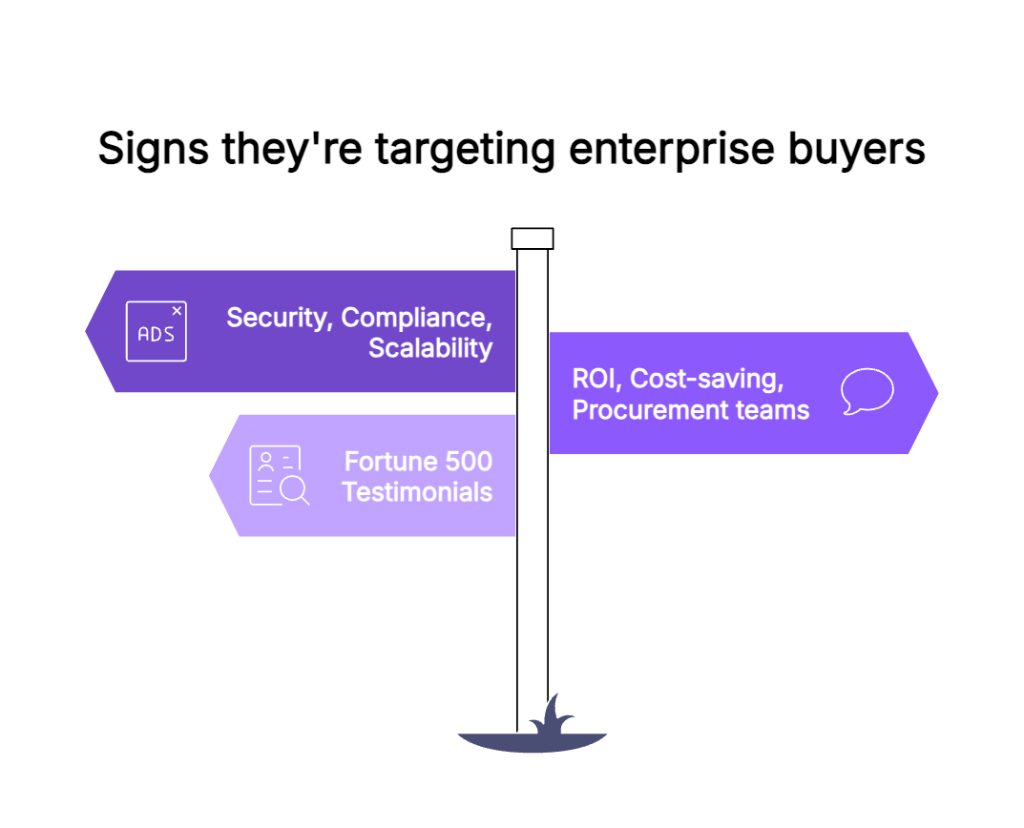
Signs they’re targeting SMBs & startups:
✅ Ads highlight ease of use, affordability, and quick setup
✅ CTA focuses on free trials or low-cost entry plans
✅ Testimonials come from founders, small teams, or solo entrepreneurs
.png)
A competitor running video ads featuring hands-on product walkthroughs is likely targeting smaller teams that prefer self-serve solutions. Meanwhile, a different competitor running case study-heavy ads with CFO testimonials is clearly after enterprise buyers.
If competitors are all chasing large enterprises, there may be less competition in SMB/mid-market segments, a great opportunity to refine your positioning.
Emerging LinkedIn Ads Trends to Watch
LinkedIn Ads, like most ad platforms are evolving fast, what worked six months ago might be losing engagement, and new formats are appearing all the time.
As we write today here are a few trends to watch out for:
Thought Leader Ads Are Outperforming Brand Ads
Not surprisingly, people trust people more than companies. More and more brands are shifting LinkedIn ad spend from corporate accounts to individual thought leaders.
Why this matters:
✅ Sponsored posts from executives or industry experts feel more authentic than brand-driven ads.
✅ Engagement rates are typically higher when ads come from a personal profile.
✅ LinkedIn’s algorithm prioritizes user-generated content, meaning these ads blend more naturally into feeds.
Example:
A fintech company tested two identical LinkedIn Ads, one from their official brand page, the other from their CMO’s personal profile. The CMO’s post generated 4X more engagement and 60% lower CPC.
What to do: Instead of only running ads from your company page, test thought-leader ads featuring insights, industry takes, or behind-the-scenes content from your CEO or key team members.
Meme-Style Ads Are Winning in Some B2B Segments
Yes, memes, on LinkedIn. Some industries are seeing meme-driven image ads dramatically outperform polished corporate creatives.
Why this matters:
✅ Memes create instant engagement by making people stop scrolling.
✅ They break the traditional B2B ad format, making your message stand out.
✅ They feel organic and shareable, boosting visibility without additional spend.
Example:
A SaaS company targeting marketers ran two versions of a LinkedIn Ad:
1️⃣ A professionally designed graphic with a stat about ROI.
2️⃣ A meme-style image with a joke about “Marketing reporting dashboards at 4:59 PM on Friday.”
The meme ad had 3X the engagement and a 40% lower CPL.
✅ What to do: If your audience appreciates humor, experiment with casual, meme-driven ads that align with their pain points or industry challenges.
Portrait Ads Are Driving Higher Engagement Than Landscape
Most LinkedIn Ads still default to landscape images and videos, but that’s not how people use their phones.
Why this matters:
✅ Portrait (vertical) ads take up more screen real estate, meaning fewer distractions.
✅ Mobile usage on LinkedIn is growing, and vertical ads maximize visibility.
✅ This format is underutilized, making it a low-competition opportunity.
Example:
A SaaS company switched from landscape to portrait video ads and saw a 22% increase in view-through rates and 15% lower CPC.
✅ What to do: When running video or image ads, test portrait (4:5 ratio) formats to see if they boost engagement, especially on mobile-heavy audiences.
Conversational Ads Are Delivering Higher CTRs
Traditional LinkedIn Ads rely on static creatives, but Conversational Ads (message-style ads in LinkedIn inboxes) are seeing strong engagement—especially for B2B lead generation.
Why this matters:
✅ Unlike display ads, these feel like direct outreach, making them more personal.
✅ They allow for interactive engagement, guiding users through a CTA flow.
✅ LinkedIn users are already in a professional mindset, making them more receptive.
Example:
A recruitment software company tested Conversational Ads vs. traditional Sponsored Content Ads for demo sign-ups. The Conversational Ads had a 2.3X higher CTR and a 20% lower cost per lead.
✅ What to do: If you’re running lead-gen or event promotion campaigns, try Conversational Ads to create a more direct, engaging experience.
Conclusion
Competitive ad tracking lets you see which brands are dominating, what messaging resonates, and where creative trends are shifting.
Using AI not only gives you better insights than ever before about what the competition are doing, it also completely eliminates any time you might have had to spend before trying to keep an eye on them all.
This technology is new and most advertisers right now either don’t know about it or don’t know how best to use it.
Get on it early and master these new tools before your competitors do!
